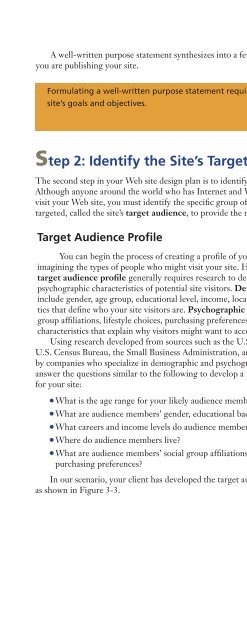(Shelly Cashman Series) Gary B. Shelly, H. Albert Napier, Ollie N. Rivers-Web design_ introductory concepts and techniques -Cengage Learning (2008)
You also want an ePaper? Increase the reach of your titles
YUMPU automatically turns print PDFs into web optimized ePapers that Google loves.
Step 2: Identify the Site’s Target Audience 73<br />
A well-written purpose statement synthesizes into a few words the reason or reasons<br />
you are publishing your site.<br />
Formulating a well-written purpose statement requires a clear underst<strong>and</strong>ing of a<br />
site’s goals <strong>and</strong> objectives.<br />
DESIGN<br />
TIP<br />
Step 2: Identify the Site’s Target Audience<br />
The second step in your <strong>Web</strong> site <strong>design</strong> plan is to identify the site’s target audience.<br />
Although anyone around the world who has Internet <strong>and</strong> <strong>Web</strong> access potentially can<br />
visit your <strong>Web</strong> site, you must identify the specific group of visitors to which your site is<br />
targeted, called the site’s target audience, to provide the most value for that audience.<br />
Target Audience Profile<br />
You can begin the process of creating a profile of your site’s target audience by<br />
imagining the types of people who might visit your site. However, developing a formal<br />
target audience profile generally requires research to determine both demographic <strong>and</strong><br />
psychographic characteristics of potential site visitors. Demographic characteristics<br />
include gender, age group, educational level, income, location, <strong>and</strong> other characteristics<br />
that define who your site visitors are. Psychographic characteristics include social<br />
group affiliations, lifestyle choices, purchasing preferences, political affiliations, <strong>and</strong> other<br />
characteristics that explain why visitors might want to access your site.<br />
Using research developed from sources such as the U.S. Department of Labor, the<br />
U.S. Census Bureau, the Small Business Administration, <strong>and</strong> reports prepared by <strong>and</strong> sold<br />
by companies who specialize in demographic <strong>and</strong> psychographic research, you can ask <strong>and</strong><br />
answer the questions similar to the following to develop a formal target audience profile<br />
for your site:<br />
• What is the age range for your likely audience members?<br />
• What are audience members’ gender, educational background, <strong>and</strong> marital status?<br />
• What careers <strong>and</strong> income levels do audience members enjoy?<br />
• Where do audience members live?<br />
• What are audience members’ social group affiliations, lifestyle choices, <strong>and</strong><br />
purchasing preferences?<br />
In our scenario, your client has developed the target audience profile for the new site,<br />
as shown in Figure 3-3.<br />
Q&A<br />
Can a <strong>Web</strong> site have<br />
more than one target<br />
audience?<br />
Yes, many <strong>Web</strong> sites<br />
have multiple target<br />
audiences. For example,<br />
the Office Depot<br />
e-commerce <strong>Web</strong> site<br />
promotes its brick<strong>and</strong>-mortar<br />
stores for<br />
walk-in customers, sells<br />
office equipment <strong>and</strong><br />
supplies online to individual<br />
consumers, <strong>and</strong><br />
offers services directed<br />
to business customers.


